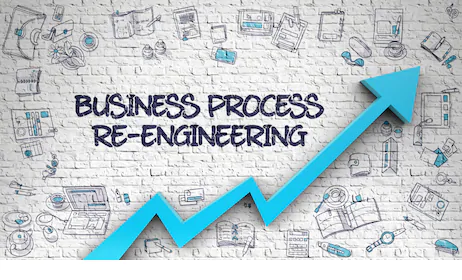Getting Started with Business Re-engineering
The purpose of business process re-engineering is to fully overhaul existing strategies. Business processes are redesigned from the bottom up with a renewed concentrate on the company’s mission and therefore the customers’ desires. for many firms, the first goal of BPR is to radically improve productivity, quality and value efficiency, reworking an organization that’s barely competitive into a heavy challenger.
When to think about Business process Re-engineering
Complete re-engineering of a business method needs important resources. In some cases, the come back on investment is simply too low to create the project worthy, and smaller improvement initiatives can fulfill. complete business process re-engineering is most acceptable for organizations faced with any or all of the subsequent challenges:
• Despite its best efforts, the organization merely cannot carry on with competitors of any size.
• Though giant capital investments are created within the current processes, the come back on investment is shrinking.
• Incremental enhancements lead to a method that’s progressively complicated and expensive, with very little in the means of improved production and quality.
• The method is clearly broken on the far side what an easy retooling or correction of a single inefficiency will correct.
• Responsibility for processes is fragmented, and a range of people and groups are concerned. once problems come back up, nobody takes accountability for finding issues and obtaining work flow up and running again.
In these situations, business process re-engineering will mean the difference between continued to struggle and obtaining back on top.
The Six Key Steps of Business process Re-engineering
1. Outline Business Processes:
Map the present state (work activities, workflows, roles and news relationships, supporting technology, business rules, etc.).
2. Analyze Business Processes:
Determine gaps, root causes, strategic disconnects, etc. within the context of rising organizational effectiveness, operational efficiency and in achieving organizational strategic objectives.
3. Determine and Analyze Improvement Opportunities:
Identify, analyze and validate opportunities to deal with the gaps and root causes known during analysis. This step additionally includes characteristic and verifying improvement opportunities that are forward facing – usually strategic transformational opportunities that aren’t bound to current state process.
4. Style Future State Processes:
Choose the development opportunities identified on top of that have the most impact on structure effectiveness, operational efficiency, which can succeed organizational strategic objectives. check that to pick out opportunities that the organization has the budget, time, talent, etc. to implement within the project time frame. create a forward-facing future-state map that comprehends the chosen opportunities.
5. Develop Future State Changes:
Frequently unnoticed (and a key root cause in unsuccessful BPR initiatives), this can be where the above opportunities are ope-rationalized before implementation. New workflows and procedures got to be designed and communicated, new/enhanced practicality is developed and tested, etc. Changes and opportunities can’t be enforced till they’re ope-rationalized.
6. Implement Future State Changes:
Classic implementation supported dependencies among changes/opportunities, modification management, project management, performance observation, etc.
Read more about Business Re-engineering and for any Query to keep your company running safely and efficiently.

